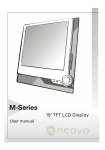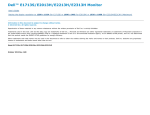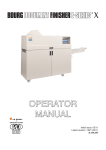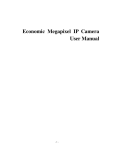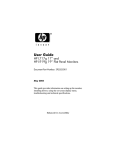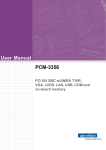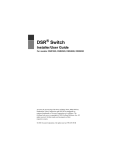Download Emprex LM-1702 Installation guide
Transcript
LCD Monitor Quick Installation Guide English Français Deutsch Italiano Español Русский 1 TABLE OF CONTENTS PRECAUTIONS.......................................................................................................... 2 INSTALLATION POWER CONNECTION MAINTENANCE……… TRANSPORTING THE MONITOR 2 2 2 2 GETTING STARTED 3 PACKAGE CONTENTS INSTALLATION OF FIRST USE IDENTIFYING PA RTS AND CONTROLS FUNCTIONS OF THE BUTTONS AND INDICATOR: SETUP CUSTOMIZING YOUR MONITOR Working with OSD Group. Introduction to Hotkeys and the Characteristic Functions…………………………………………. OSD Icon list …………………………………………………………………………………………… TROUBLESHOOTING 3 4 4 4 5 6 6 6 7 9 TECHNICAL FEATURES AND SPECIFICATIONS............................................................................. 10 INTERFACE FREQUENCY………………………………………………………………………………. 11 SUPPORTED TIMING LIST………………………………………………………………………………. 12 ADDENDUM 14 REGULATIONS 16 FCC COMPLIANCE…………………………………………………………………………………………16 TCO’99..................................................................................................................................................... 2 17 Precauciones Installation 1. Do not cover or block the ventilation ports on the rear of the monitor. 2. Do not install the monitor close to heat sources such as radiators or air ducts, or in a location exposed to direct sunlight, excessive dust, mechanical vibration, or shock. Power connection 1. 2. 3. 4. 5. 5.1 5.2 5.3 5.4 Use the correct power cord for your local voltage. Use an accessible outlet close to the monitor. Do not allow anything to rest on the power cable. Only use the power adapter attached to the monitor. Disconnect the power cable from the power supply if: You will not use the monitor for an extended period. The cable is damaged or frayed. The monitor has been dropped or the cabinet damaged. A distinct change in performance indicates a need for servicing. Maintenance 1. Clean the cabinet and controls wit h a soft cloth lightly moistened with a mild detergent solution. Do not use any abrasive materials or solvents such as alcohol or benzene. 2. Do not rub, touch, or tap the surface of the screen with sharp or abrasive items such as pens or screwdrivers, as the screen may scratch. 3. Do no t insert objects or spill liquids into the ventilation ports on the monitor’s rear, a s fire, electric shock, an d / or unit failure may result. Transporting the monitor 1. When transporting the monitor for repair or shipment, fold the base of the monitor back until it becomes straight. Then wrap the monitor and its attachments with the original carton and packing materials. 3 Getting Started Package contents Before beginning, ensure that the carton contains the following items: 1. LCD Monitor 2. Power cord (The plug may vary according to the electrical standard for your area) 3. Video Signal Cable (Analog, D-S U B Cable) 4. Audio cable (optional) 5. CD-ROM (Contains the driver of the monitor, this user’s manual and other information) 6. Quick Installation Guide 4 Installation of First Use 1. The installation ofthe monitor is very simple. Take the monitor from the packing box and remove all the packing materials. And then put the monitor on the desk carefully; fold the monitor base, so that the monitor can stand on the desk properly. Next, adjust the monitor t o the desired position according to the seat and other factors. Identifying parts and controls 1. The LED indicator and control buttons are as follows: 2. The connection ports are as follows: Functions of the buttons and indicator: Button Indicador LED 1. 2. 3. 4. 1. 2. 3. 1. 2. 3. Functions Turn on the monitor Activate the OSD control menu Select the specific function Turn off the monitor by pressing the button for 3 seconds Activate the Volume control menu, and increase the value (optional) View the next function in the main OSD menu clockwise Increase the value of specific function which has been selected Activate the Volume control menu, and decrease the value (optional) View the next function in the main OSD menu counter-clockwise Decrease the value of the specific function which has been selected 1. Optimize the picture performance automatically 1. Green color indicates that the monitor is in “active” mode (normal operation). Amber color indicates that the monitor is in “sleep” mode (power saving mode or no signal input). Not lit indicates that the monitor is in “off” mode (monitor power off). 2. 3. 5 Setup 1. Connecting video (Note: Before connecting computer, ensure the resolution and refresh rat e of the computer do not exceed the following setting s - resolution: 1280*1024, refresh rate: 75Hz.) 1.1 Turn off your computer 1.2 Connect the video signal cable to the VGA port of your PC, tighten the screws on the connector onto the computer 1.3 Connect the other end of the video signal cable to the VGA-IN port at the back of the monitor, tighten the screws on the connector to the monitor 2. Connecting power 2.1 Plug the female end of the power cord in to the AC-IN port at the back of the monitor 2.2 Plug the male end of the power cord into a power outlet 3 Connecting audio (optional) 3.1 Plug the audio cable into the AUDIO port at the back of the monitor 3.2 Plug the other end of the audio cable into your computer or other audio source 4. 5. 6. Turning on the computer Pressing the button at the back of the monitor to turn on the monitor Removing the protection film from the monitor You should be able to see the picture now. I f not, refer to the “Troubleshooting” section. 6 Customizing your Monitor The On Screen Display (OSD) system provides a full range of customizable tools to optimize your display. While full customization is available, we strongly recommend using the Auto Adjustment function, which is preset to fully optimize your monitor’s performance. Simply press the & buttons simultaneously to engage the Auto Adjustment. It is also recommended that you execute the function following any change made to your display from your computer. Important: W orking with OSD Group 1. Press Menu 2. Select the icon from the OSD menu with the 3. Press Menu 4. Press 5. Press Menu 6. Press or or button to activate the OSD menu. & buttons. button to confirm the selection of a specific function to adjust the setting values. button to exit from the sub-menu. to select the Exit icon, and then press the Menu button to exit from the OSD menu. Introduction to Hotkeys 1. Auto Adjustment While the OSD menu is not shown, press automatically & buttons simultaneously to optimize the picture performance (You may also use the OSD control to activate the Auto Adjustment function. See OSD Menu and Icon List section) 2. Volume Control (optional) While the OSD menu is not shown, press or button to increase or decrease the audio volume level. 7 OSD Icon List Icon Functions Auto Adjustment Detail Optimize the picture performance automatically (you may also press _ an d _ buttons simultaneously , while the OSD menu is not shown, to activate the function) Brightness Adjust the luminance level of the screen Contrast Adjust the contrast level (black to white ratio) of the screen Sharpness Adjust the sharpness of the screen Clock Adjust the monitor’s internal sampling clock rate Phase Adjust the monitor internal signal phase Horizontal Position Shift the position of the screen left or right Vertical Position Shift the position of the screen up or down Color Temperature Select the setting of screen color – Cool, Warm or User Cool (9300K) Select the setting of screen color to be bluish white Warm (6500K ) Select the setting of screen color to be reddish white User Adjust the setting of screen color per the user’s preference R Adjust the percentage of red color G Adjust the percentage of green color B Adjust the percentage of blue color OSD Menu Language Select your own preference of language of OSD menu There are 9 languages available – English, German, French, Italian, Spanish, Japanese, Simplified Chinese, and Traditional Chinese. 8 OSD Menu Position Adjust the position of OSD menu on the screen. Power Saving Mode Standard Select between Standard and Advanced power saving modes. See addendum for details Fulfill EP A Energy Star power management requirement Advanced Activate monitor Life-Extension function Recall Factory Preset Reset monitor parameters back to factory preset values. Exit Disable the OSD menu 9 Troubleshooting 1. 2. Symptom No picture LED indicator (at the right side of the monitor) is not lit 1. 2. 3. 1. 2. No picture LED indicator (at the right side of the monitor) is orange 1. 2. 3. Check Items Check if the monitor is turned on (press the button again). Check if the power cord is properly connected to the monitor and power outlet. Check if there is electricity coming from the power outlet (use another device to check for power). Check if your computer is turned on. Ensure the computer is not in power saving mode (move the mouse or press a key on the keyboard to wake up the computer). Check if the video signal cable is properly connected to the monitor and computer. 1.Picture shows “No Signal Input” 1. 2. Check if your computer is turned on. Check if the video signal cable is properly connected to the monitor and computer. 1.Picture shows “Input Signal Out of Range” 1. Ensure that the resolution and/or refresh rate is set correctly. (See item 2.1 of Monitor Installation section) 1.Picture not clear 1. Press buttons simultaneously to activate the Auto Adjustment function. 2. Check if the video signal cable is properly connected to the monitor and computer. 3. Adjust the screen resolution and refresh rate of your computer to SXGA. (resolution: 1280*1024, refresh rate: 60Hz) for the best performance 10 Technical Features and Specifications Item LCD Display Display Size Pixel Pitch Resolution Maximum Recommended Max. Display Color Brightness Contrast Ratio V iewing Angle L/R (CR_5) U/D Response T ime (T r+Tf) Signal Input Analog Description 17" TFT active matrix panel 337.92(H ) x 270.336(V) mm 0.264(H ) x 0.264(V) mm SXGA 128 0 x 1024 @75Hz SXGA 128 0 x 1024 @60Hz 16.2M colors 300 cd/m2 (typ.) 500 G1 (typ.) 160° (typ.) 160° (typ.) 12 ms (typ.) D-sub 15 pin Input Frequency Range Horizontal: 31.5KHz to 80KHz Vertical: 56Hz to 75Hz LED Indicator VESA Mounting Hole Plug & Play Speakers (Optional) OSD Controls Standby: Amber / Active: Green 75 x 7 5 (mm) VESA DDC 1/2B compliance 1W x 2 3 buttons at back (Power/Menu, Adjustment +/-) OSD Functions Power Input Power Consumption Color Operating Temperature Conditions Humidity Altitude Storage Conditions Temperature Humidity Altitude Dimensions Package Dimensions Net W eight Gross W eight Auto Adjustment, Brightness, Contrast, Sharpness, Phase, Clock, H. Position, V. Position, Color Temperature, Power Saving Mode, OSD Menu Position, OSD Menu Language, Recall, Volume (optional) 9 languages (including English, German, French, Italian, Spanish, Japanese, Simplified Chinese, Traditional Chinese) AC 100~240 V, 47Hz~63H z Active: < 35 W / Standby: < 1 W Silver or Black 5℃ to 40℃ (℉ to℉) 20%-80% (No Condensation) 10,000 fts -20℃ to 60℃ (-4℉F to 140℉) 5%-90% (No Condensation) 40,000 fts 38 (W) x 387(H) x 190(D) mm 438(W ) x 516(H) x 110(D) mm 3.4kg 4.7kg Certification UL, CE, TUV/GS, FCC-B, BSMI, CCC, Energy Sta, TCO'99 (optional) OSD Language 11 Interface Frequency 1. The following frequency range is the working period. If the entered mode is between the below period but does not match the frequency of supported timing, display optimization will not be assured. If the entered mode is out of the working period, the display will be blank (just show “Input Signal Out Of Range”) then go to power saving. 2. Basically , mode judgment is regardless the sync polarity except if both or more modes all belong to the supported timing list and can be judged by sync polarity only. 3. In the meantime, the real entered frequency of the supported timing is not requested exactly. 4. Normalization of the VGA card’s deviation will be acceptable. 5. Horizontal Frequency 30 KHz---80 KHz 6. Vertical Frequency 50 Hz---75 Hz 12 Supported timing list 1. If the selected timing is NOT included in table below, this LCD monitor will use the most suitable available timing. 13 Note: When the input display mode is not 128 0 X 1024, the image is smoothly expanded to1280 X 1 02 4 dots with scaling engine. After expansion from 65 0 X 350, 64 0 X 400, 64 0 X 480, 72 0 X 400, 83 2 X 6 24, 80 0 X 600, and 1024 X 7 68 resolution, the text may look no t so sharp, and the Graphics may not look proportional. 14 Addendum Advanced Power Saving M ode 1. Background The traditional monitors have the function of electricity-saving dormancy. Bu t the interval of dormancy is difficult to decide. If the interval is long, the purpose of saving electricity can not be achieved. While if the interval is short, y our computer and LCD monitor will be dormant often. When the LC D monitor becomes dormant, the back lights w ill be turned off immediately. The frequent turning-on and turning-off of lights will result in the lightness being uneven and even, shortening the life of the lights. 2. Our solution to the dilemma – Monitor the Life-Extension function In view of that, we have designed the function of Monitor Life-Extension. Once you s elect the option of “Advanced Power Saving Mode” in the OSD menu, and then you ca n not only save electricity, but extend the life of the lights. 3.Working principle of the Monitor Life-Extension function To minimize the impact of frequent turn-on and turn-off of L CD monitor, the Life-Extension function decreases the electricity supplied to the back-light of LCD monitor gradually , instead of cutting it off right away when the P C enters sleeping or off mode. Please see the following comparison graphics for details. * Standard Power Saving Mode (without Monitor Life-Extension function) Power * Advanced Power Saving Mode (with Monitor Life-Extension function) Power ON Sleep Start Power Saving Start This “Slow-Start-n-Delay-Off” approach minimizes the transit of electricity and temperature caused by the turning-on and turning-off of the LCD monitor. Therefore, the decay of backlight s o f T FT -LCD ca n be controlled at the certain level which is much less than it was. 4. The side effect of the Monitor Life-Extension Saving Mode as default?) function (why not preset Advanced Power According to the request of EP A (US Environmental Protection Agency) to power management of monitors, the power consumption of the monitor must go down to below 3 watts within 3 seconds after the monitor s goes into power s aving mode. Bu t the Life-Extension function decreases the electricity supplied to the backlights of LCD monitor gradually.Therefore, the Monitor L ife-Extension function has a conflict with the requirement of E PA in the first 7 minutes after entering sleeping mode. Even though,comparing the advantage s o f both conditions, we still recommend you strongly set your monitor to Advance d Power Saving mode. 15 5.l How can you engage the Monitor Life-Extension function? You may simply use the OSD control to activate the Monitor Life-Extension function. 1. Press the Menu 2. Press or 3. Press the Menu 4. Pres or button to select the Power Saving Mode icon. button to confirm the selection button to select the “Advanced” option in the Power Savin g Mode function. 5. Press the Menu 6. Press button to activate the OSD menu o 7. Press the Menu button to confirm the selection button to select the Exit icon. button to exit the OSD menu 16 Regulations FCC compliance 1. This device complies with Part 15 of the FCC Rules. Operation is subject to the following two conditions (1) this device may not cause harmful interference, and (2) this device must accept any interference received, including interference that may cause undesired operation. 2. NOTE: This equipment has been tested and found to comply with the limits for a Class B digital device, pursuant to part 15 of the FCC Rules. These limits are designed to provide reasonable protection against harmful interference in a residential installation. This equipment generates, uses and can radiate radio frequency energy and, if not installed and used in accordance with the instructions, may cause harmful interference to radio communications. However, there is no guarantee that interference will not occur in a particular installation. If this equipment does cause harmful interference to radio or television reception, which can be determined by turning the equipment off and on, the user is encouraged to try to correct the interference by one or more of the following measures: 3. Reorient or relocate the receiving antenna. 4. Increase the separation between the equipment and receiver. 5. Connect the equipment to an outlet on a circuit different from that to which the receiver is connected. 6. Consult the dealer or an experienced radio/TV technician for help. WARNING: Any unauthorized modification to this equipment could result in the revocation of the authorization to operate the equipment and void the product warranty. 17 TCO’99 Congratulations! You have just purchased a TCO’99 approved and labeled product! Your choice has provided you wit h a product developed for professional use. Your purchase has also contributed to reducing the burden on the environment and also to the further development of environmentally adapted electronics products. Why do we have environmentally labeled computers? In many countries, environmental labeling has become an established method for encouraging the adaptation of goods and services to environment. The main problem, as far as computers and other electronics equipment are concerned, is that environmentally harmful substances are used both in the products and during their manufacture. Since it has not so far been possible to satisfactorily recycle the majority of electronics equipment, most of these potentially damaging substances sooner or later enter nature. There are also other characteristics of a computer, such as energy consumption levels, that are important from the viewpoints of both the work (internal) and natural (external) environments. Since all methods of electricity generation have a negative effect on the environment (e.g. acidic and climate-influencing emissions, radioactive waste), it is vital to save energy . Electronics equipment in offices is often left running continuously and thereby consumes a lot of energy. What does labeling involve? This product meets the requirements for the TCO’99 scheme which provides for international and environmental labeling of personal computers. The labeling scheme was developed a s a joint effort by the TCO (The Swedish Confederation of Professional Employees), Svenska Naturskyddsforeningen (The Swedish Society for Nature Conservation) and Statens Energimyndighet (The Swedish National Energy Administration). Approval requirements cover a wide range o f issues: environment, ergonomics, usability, emission of electric and magnetic fields, energy consumption and electrical and fire safety. The environmental demands impose restrictions on the presence and use of heavy metals, brominated and chlorinated flame retardants, CFCs (freons) and chlorinated solvents, among other things. The product must be prepared for recycling and the manufacturer is obliged to have an environmental policy which must be adhered to in each country where the company implements its operational policy. The energy requirements include a demand that the computer and/or display, after a certain period of inactivity, shall reduce its power consumption to a lower level in one or more stages. The length of time to reactivate the computer shall be reasonable for the user. Labeled products must meet strict environmental demands, for example, in respect of the reduction of electric and magnetic fields, physical and visual ergonomics and good usability. Below you will fin d a brief summary of the environmental requirements met by this product. The complete environmental criteria document may be ordered from: TCO Development SE-1 14 94 Stockholm, Sweden Fax:+4687829207 Email (Internet): [email protected] Current information regarding TCO’99 approved and labeled products may also be obtained via the Internet, using the address: http://www .tco-info.com/ 18 Environmental requirements Flame retardants Flame retardants are present in printed circuit boards, cables, wires, casings and housings. Their purpose is to prevent, or at least to delay the spread of fire. Up to 30% of the plastic in a computer casing can consist of flame retardant substances. Most flame retardants contain bromine or chloride, and those flame retardants are chemically related to another group of environmental toxins, PCBs. Both the flame retardants containing bromine or chloride and the PCBs are suspected of giving rise to severe health effects, including reproductive damage in fish-eating birds and mammals, due to the bio-accumulative processes. Flame retardants have been found in human blood and researchers fear that disturbances in foetus development may occur. The relevant TCO’99 demand requires that plastic components weighing more than 25 grams must not contain flame retardants with organically bound bromine or chlorine. Flame retardants are allowed in the printed circuit boards since no substitutes are available. Cadmium* Cadmium is present in rechargeable batteries and in the color-generating layers of certain computer displays. Cadmium damages the nervous system and is toxic in high doses. The relevant TCO’99 requirement states that batteries, the color-generating layers of display screens and the electrical or electronics components must not contain any cadmium. Mercury Mercury is sometimes found in batteries, relays and switches. It damages the nervous system and is toxic in high doses. The relevant TCO’99 requirement states that batteries may not contain any mercury. I t also demands that mercury is not present in any o f the electrical or electronics components associated with labeled unit. CFC s (freons) The relevant TCO’99 requirement states that neither CFCs nor HCFCs may be used during the manufacture and assembly of the product. CFCs (freons) are sometimes used for washing printed circuit boards. CFCs break down ozone and thereby damage the ozone layer in the stratosphere, causing increased reception on earth of ultraviolet light with e.g. increased risks of skin cancer (malignant melanoma) a s a consequence. Lead** Lead can be found in picture tubes, display screens solders and capacitors. Lead damages the nervous system and in higher doses, causes lead poisoning. The relevant TCO’99 requirement permits the inclusion of lead since no replacement has yet been developed. * Bio-accumulative is defined as substances which accumulate within living organisms. ** Lead, Cadmium and Mercury are heavy metal s which are Bio-accumulative. 19



















